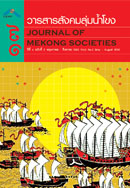The Construction of National Consciousness Through Lao Revolutionary Songs From the End of World War II to Present
Main Article Content
Abstract
The objective of this study is to examine the construction of national consciousness through Lao revolutionary songs from the end of World War II to present. The revolutionary songs are classifi ed in to three periods: the anti-French period, the anti-American period, and the liberation period. The study shows that during the anti-French period (1893-1954), the revolutionary songs emphasized the presence of the enemy in an attempt to arouse people to begin uprisings. During the anti-American period (1954-1975), the songs still highlighted the nation’s enemy and a sense of nationalism. The songs also emphasized the identity of the nation comprising people in different occupations which were important to the national prosperity and security. During this time, under the leadership of Lao People’s Revolution Party, Lao people were sharing a sense of brotherhood and believed in the equality of all Laotians. This was when the revolutionary songs were used most frequently. During the period of liberation (after 1975–present), the number of revolutionary songs declined dramatically because the war had ended. There was no longer an emphasis on the nation’s enemy but instead the songs focused on praising the Lao People’s Revolution Party and were used to celebrate international friendships.


